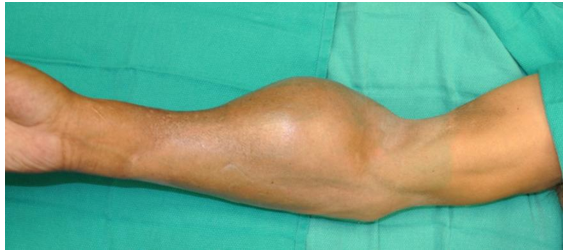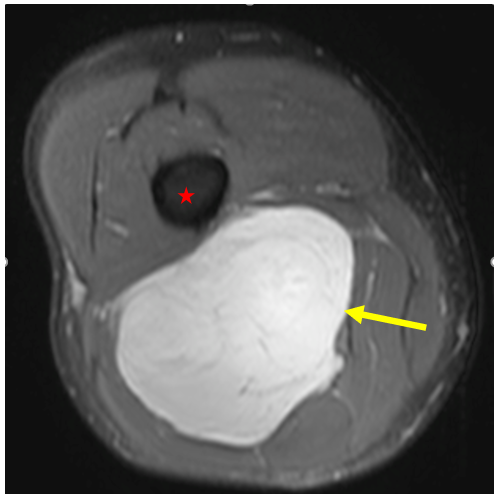Author: Raffi S. Avedian, MD
Description
Liposarcoma is a type of cancer that originates from fat tissue. It most commonly occurs in the arms, legs, pelvis and abdomen, but can occur in other parts of the body. It can grow deep in the muscles or more superficial just under the skin. There are different types of liposarcoma such as myxoid liposarcoma, round cell liposarcoma, dedifferentiated liposarcoma, and others. Liposarcomas are treated similar to other soft tissue sarcomas (please see section on soft tissue sarcoma).
Symptoms
The main symptom people feel is a lump where the tumor is growing. Liposarcomas rarely cause pain or other symptoms.
Examination
The most common finding on physical exam is the presence of a nonpainful lump or mass, (Figure 1). It may be big (8-9 inches) or small (1-2 inches) but most tumors are somewhere in between.
Tests
The most important test is an MRI scan of the tumor (Figure 2). A biopsy by a sarcoma specialist is needed to confirm the diagnosis after which additional testing to see if the tumor has spread to other parts of the body is performed. This testing includes a cat scan of the lungs, abdomen, and pelvis and sometimes an MRI of the spine. Blood tests do not play a role in diagnosing liposarcoma.
Images
Figure 1 Picture of a man with a large arm mass that a biopsy showed to be liposarcoma. Liposarcomas can be much smaller or even large than the one shown in this photo.

Figure 2 MRI scan of a thigh showing liposarcoma (yellow arrow) growing in the hamstring muscle. The red star indicates the femur bone.

Prognosis
Prognosis for liposarcoma is similar to other soft tissue sarcoma and depends on the stage of the tumor which is made up of the factors below:
- Grade: how aggressive cancer cells look under the microscope.
- Size: small tumors under 2 inches have the best prognosis while large tumors over 4 inches have a worse prognosis.
- Metastasis: when tumor spreads to another part of the body it is called metastasis.
The treatment for liposarcoma often includes surgery, radiation and sometimes chemotherapy. It is important for patients to consult with a team of doctors who specialize in sarcomas to determine the best options for their specific condition. Oncology orthopedists have the specialized expertise needed to guide treatment decisions in cases where the tumor involves the limbs or musculoskeletal system.
More Information:
AAOS orthoinfo: https://www.orthoinfo.org/en/diseases--conditions/soft-tissue-sarcomas/
Sarcoma Alliance: https://sarcomaalliance.org/
National Organization for Rare Disorders: https://rarediseases.org/rare-diseases/liposarcoma/
This is not intended as a substitute for professional medical advice and does not provide advice on treatments or conditions for individual patients. All health and treatment decisions must be made in consultation with your physician(s), utilizing your specific medical information. Inclusion in this is not a recommendation of any product, treatment, physician or hospital.


